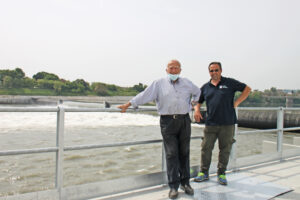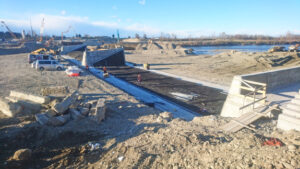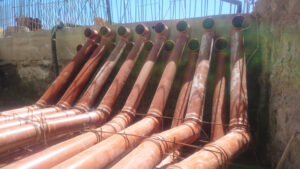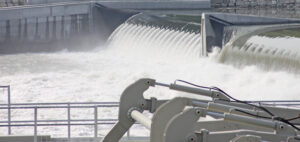Hydro-Construct supplies the biggest rubber dam in Europe for the River Po in Piedmont, Italy
Austrian Hydro-Construct GmbH completed this project successfully on the River Po in the famous Piedmont region of Italy in 2020. The rubber dam is part of the Casale Monferrato hydropower plant – named after the nearby town. The Austrians supplied a rubber dam with four spans – at an overall length of 200 m. At a regulation height of 4.3 m this structure is the biggest of its kind in Europe, and the largest project Hydro-Construct has ever built. The rubber dam has a flexible, heavy-duty membrane and operates as a water-inflated system to ensure the water level in the reservoir remains at an exact height, regardless of river flow volumes – while also allowing the free passage of floodwater extremes. Despite the general difficulties caused by the corona crisis, the 4.4 MW power plant was successfully commissioned and put into operation that May.

© Hydro-Construct
The Austrian company Hydro-Construct is known for breaking its own records. Especially considering the dimensions of this flexible weir system. Compared with conventional technologies, the advantage of this rubber dam system is its use for damming reservoirs on broad rivers without the need of fixed weir structures that artificially narrow the flow opening. Hydro-Construct supplied another large rubber dam with an overall length of 265 m and a height of 2.3 m in Albania in 2012, and in 2017, in Uttar Pradesh in India a further project was installed at 270 m in length and at a height of 3.2 m. These innovative solutions are available for regulation heights up to 4.5 m. This kind of system has also been implemented in Turkey and France. The project on the River Po involved the installation of a rubber dam with 4 spans at an overall length of 200 m, and a regulating height of 4.3 m, near the town of Casale Monferrato in Piedmont. This project enabled Hydro-Construct to set a new European record for rubber dams.

© Hydro-Construct
Best practice co-operation
Hydro-Construct’s CEO DI Dr. Rudolf Fritsch explains that this hydro project was developed by the privately-owned company Idro Baveno S.r.l. from Turin. Idro Baveno CEO, Constanzo Villosio, and his nephew Sebastiano are the driving forces behind this important project. The co-operation was reportedly a success the first time around, as in 2012 Hydro-Construct supplied this company with a 2-span rubber dam for Casalgrasso at a length of 215 m and a height of 1.2 m. Rudolf Fritsch reveals that the project costs of 26 million euros for a hydroelectric power plant with a head of just 5 m and a rated flow of 4 x 30 m³/s are only feasible with supported feed-in tariffs. This is an example of a private initiative development designed to generate renewable energy. The hydroelectric power plant is equipped with vertical Kaplan turbines and synchronous generators supplied by the Italian company Scotta S.p.A. The capacity of the power plant is 4.4 MW and annual production of renewable energy is 25 million kWh.
20 tons per membrane
Hydro-Construct has enjoyed increasing success in the upper Italian area of Piedmont. To date 8 rubber dam projects have been implemented here. The Casale Monferrato project was supplied and installed between February and December 2019, commissioning took place in 2020. Internal resources were challenged by the need to complete within this short installation period. Hydro-Construct was supported by their partner companies Aquatis of Brno, who provided engineering and installation management, and Rubena of Nachod, who produced the membranes with an endless vulcanisation press and incorporated four layers of fibre fabric. The membrane is 22 mm thick in dimensions of 60 m by 15 m. Each piece of the membrane weighs 20 metric tons.

© Hydro-Construct
Austrian / Italian partnership
Mr. Fritsch informed that the dimensions and the weight of the rolled-up membrane posed transport logistics problems and construction site handling challenges. Installation of one span took around two weeks. A precondition for installation of the membranes was completion of the concrete structures with embedded fittings for clamping and for the pipe system. He was complimentary about the collaboration with all the companies involved in construction work: “Every aspect of the cooperation with other companies went smoothly, and it must be mentioned that our Italian partner company, Puntel & Capellari & Associati Ingegneria from Udine, deserves praise for their complete dedication in the preparation of the entire project. Dr. Ing. Michaela Diracca was especially helpful with her technical expertise and charm. She provided important support to Hydro-Construct and made a strong impact on the success of the project.”

© Hydro-Construct
Separate regulation of spans
The 4 weir spans are operated by two separate control units: one for the middle spans and the other for the end spans. The operating system enables both systems to communicate with each other, running in automatic mode in regular use. For maintenance purposes, all four spans can be operated manually, and a special operating mode for flushing sediments during reservoir regulation has also been implemented. It is technically feasible to regulate each span separately and this solution was implemented at the Indian project in Uttar Pradesh where the dam is 270 m wide and 3.2 m high. Hydro-Construct is co-operating with the Austrian company ESA on the supply of electric and electronic operation & control equipment of rubber dams. ESA supplied and installed all the electric and electronic equipment for Casale Monferrato. The operating system is fully automatic and ESA experts can be linked up via the internet if required.

© Hydro-Construct
System secured multiple times
The regulation system is situated in a shaft building which is 12 m deep, and in which all the regulation devices such as pumps, valves and motor drive systems are installed. The building is located on the left bank near the hydroelectric power plant powerhouse. The regulation shafts have different functions with water being filled in and drained out by pumps. These are connected to the weir by a pipe system and are like ‘communicating vessels’. The drainage pump and outlet valve enable the rubber dam to be lowered downwards continuously until its body drops completely to the weir sill. To guarantee the highest standard of safety, Hydro-Construct rubber dams feature a threefold safety system: Firstly, the overflow section infill shaft triggers a pressure limiter. Secondly, there’s the manually opened outlet valve and, thirdly, there’s an automatic discharge device for a defined water pressure limit. This works even during electricity power supply black-outs.

© Hydro-Construct
Summary and prospects
Construction of the Casale Monferrato project was influenced by the restrictions and negative impacts of the corona crisis. Moreover, atypically strong flooding in the area of the construction site delayed construction. Ultimately, the project was completed in May 2020 and the power plant was then able to commence production of renewable electric energy. Rudolf Fritsch says: “The Casale Monferrato project shows that on broad rivers there are no restrictions to the number of rubber dam spans. Technically and economically feasible hydropower solutions can be achieved up to the maximum applicable height of 4.5 m.” The next rubber dam projects in Northern Italy are already in the pipeline and Hydro-Construct is ready to serve the market with their economical expertise and best technical practices.